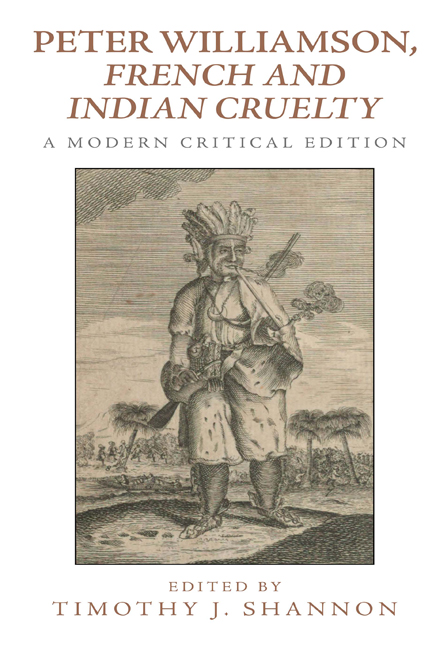Editor’s Introduction
Published online by Cambridge University Press: 16 November 2023
Summary
Peter Williamson carved a singular niche for himself in the eighteenth-century British Empire. A native of Aberdeenshire, he traveled to North America as a young indentured servant and spent thirteen years there as a laborer and soldier until he was taken as a prisoner of war by a French army and its Indian allies at the outset of the Seven Years War (1756–1763). After a brief internment in Canada, he boarded a ship packed with other prisoners bound for Plymouth, England, where he arrived in November 1756. Discharged from the army four months later, he found himself nearly penniless and more than 600 miles from home. One odyssey was over, but another was just beginning.
During the course of the next year, Williamson made his way back to Scotland as a “stroller,” or what we might call today a vagrant or tramp. During this trek, he struck upon a novel way of making his living: donning the dress of a North American Indian, he displayed himself in taverns and coffeehouses and told tales of his American adventures. In particular, he claimed that during the brief interlude between his indentured servitude in Pennsylvania and his military service, he had been taken captive by Indians, who had tortured him and forced him to witness similar atrocities they committed against other frontier settlers. Audiences, their curiosity piqued by news about Britain's military misfortunes in North America, paid to see Williamson's performances and to read his autobiographical narrative, French and Indian Cruelty; Exemplified in the Life and various vicissitudes of Fortune of Peter Williamson, which he published in York in 1757.
When Williamson finally arrived in Aberdeen in June 1758, he attracted attention by traveling around the city in a sedan chair while dressed in his Indian costume. He continued his performances and hawked copies of his narrative in the city's marketplace, but local authorities bristled at his presence. They associated strollers with thievery and other crimes and suspected that a stranger like Williamson, telling a tale of misadventures in a distant land, may very well have been trying to fleece the gullible and sympathetic for alms. But even more disturbing was a claim that Williamson made in his narrative that he had been kidnapped from Aberdeen many years earlier as part of the city's trade in indentured servants.
- Type
- Chapter
- Information
- Peter Williamson, French and Indian CrueltyA Modern Critical Edition, pp. vii - xxiiPublisher: Edinburgh University PressPrint publication year: 2023



